-
 Bitcoin
Bitcoin $115100
-2.99% -
 Ethereum
Ethereum $3642
-1.38% -
 XRP
XRP $3.027
-5.51% -
 Tether USDt
Tether USDt $1.000
-0.05% -
 BNB
BNB $763.4
-1.32% -
 Solana
Solana $177.2
-5.42% -
 USDC
USDC $0.9999
-0.02% -
 Dogecoin
Dogecoin $0.2247
-6.47% -
 TRON
TRON $0.3135
0.23% -
 Cardano
Cardano $0.7824
-4.46% -
 Hyperliquid
Hyperliquid $42.53
-0.97% -
 Stellar
Stellar $0.4096
-6.09% -
 Sui
Sui $3.662
-2.61% -
 Chainlink
Chainlink $17.63
-3.57% -
 Bitcoin Cash
Bitcoin Cash $536.3
2.94% -
 Hedera
Hedera $0.2450
0.34% -
 Avalanche
Avalanche $23.23
-3.15% -
 Litecoin
Litecoin $112.2
-1.23% -
 UNUS SED LEO
UNUS SED LEO $8.976
-0.30% -
 Shiba Inu
Shiba Inu $0.00001341
-2.72% -
 Toncoin
Toncoin $3.101
-2.44% -
 Ethena USDe
Ethena USDe $1.001
-0.05% -
 Uniswap
Uniswap $10.08
-1.97% -
 Polkadot
Polkadot $3.938
-2.77% -
 Monero
Monero $323.9
0.87% -
 Dai
Dai $0.9999
-0.02% -
 Bitget Token
Bitget Token $4.481
-1.69% -
 Pepe
Pepe $0.00001199
-5.94% -
 Aave
Aave $288.2
-0.68% -
 Cronos
Cronos $0.1279
0.36%
How much does a Bitcoin miner cost?
A Bitcoin mining rig's cost, driven by ASIC efficiency and power consumption, ranges from $3,500 to over $10,000, with hidden expenses like electricity, cooling, and maintenance significantly impacting profitability.
Jul 24, 2025 at 10:56 pm
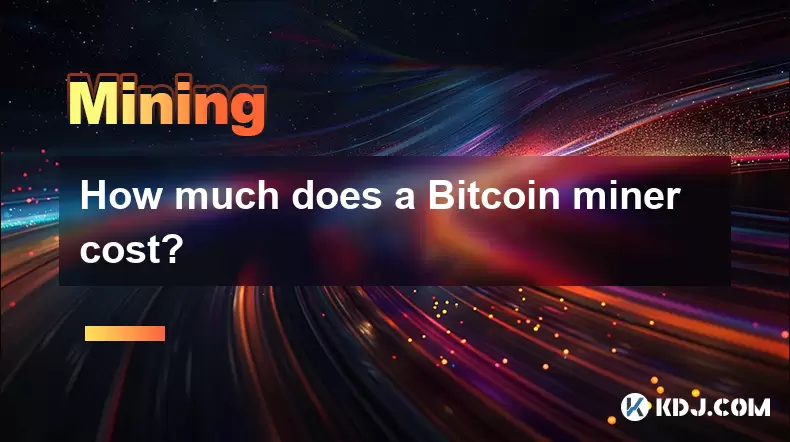
Understanding the Components of a Bitcoin Mining Rig
When evaluating how much a Bitcoin miner costs, it's essential to understand that a mining rig isn't a single component but a system built for high-performance cryptographic computation. The core of this system is the ASIC (Application-Specific Integrated Circuit), a specialized chip designed exclusively for mining Bitcoin. Unlike general-purpose GPUs, ASICs are optimized for the SHA-256 hashing algorithm used in Bitcoin mining, making them vastly more efficient. Popular models include the Antminer S19 Pro, Whatsminer M50S, and Innosilicon A11 Pro, each varying in hash rate, power efficiency, and price.
The cost of the ASIC itself dominates the total expense. For example, the Antminer S19 XP Hyd can exceed $10,000 due to its high hash rate of 255 TH/s and advanced cooling. However, the ASIC is only one part of the setup. Additional components include a power supply unit (PSU), which must be industrial-grade to handle continuous operation at high wattage—often 1,500W to 3,500W. These PSUs are not standard computer parts and can cost between $150 and $500, depending on efficiency and reliability.
Other necessary accessories include network cables, cooling systems, and mounting racks. In large-scale operations, miners also invest in noise dampening enclosures or immersion cooling tanks to manage heat and sound. These auxiliary costs may seem minor individually but can add hundreds of dollars when scaling up.
Current Market Prices for Leading Bitcoin Miners
The price of a Bitcoin miner fluctuates based on model, availability, and market demand. As of 2024, the Antminer S19 Pro (110 TH/s) is priced between $3,500 and $5,000 on secondary markets, though new units from authorized dealers may cost more due to supply constraints. The newer S19 XP (140 TH/s) ranges from $6,000 to $8,000, reflecting its improved efficiency and higher output.
The Whatsminer M50S, offering 126 TH/s, typically sells for $4,800 to $6,200. Meanwhile, the Innosilicon A11 Pro (246 TH/s) commands a premium, often priced above $9,000 due to its exceptional performance. These prices are subject to change based on global semiconductor supply, regulatory shifts, and Bitcoin’s market price, which influences mining profitability and demand.
It's also important to consider shipping and import duties, which can significantly increase total cost. Some manufacturers charge $300–$800 for international shipping, especially for bulk orders. Import taxes in certain countries may add 10–25% to the final price, making location a critical factor in overall expenditure.
Factors Influencing Bitcoin Miner Pricing
Several variables determine the final cost of a Bitcoin mining device. Hash rate is the most critical—measured in terahashes per second (TH/s)—indicating how many calculations the miner can perform each second. Higher hash rates increase the probability of earning Bitcoin rewards but come at a higher price.
Power efficiency, expressed in joules per terahash (J/TH), directly affects operating costs. A miner with lower J/TH consumes less electricity for the same output, making it more valuable over time. For instance, the Antminer S19 XP operates at around 18 J/TH, while older models may exceed 30 J/TH, making them less desirable despite lower upfront costs.
Manufacturing origin and brand reputation also influence pricing. Machines from Bitmain, MicroBT, and Innosilicon dominate the market due to reliability and firmware support. Counterfeit or gray-market units may appear cheaper but often lack warranty and pose security risks. Additionally, production cycles affect availability—new models can be backordered for months, driving up prices on resale platforms like eBay or ASICMarket.
Hidden and Ongoing Costs of Bitcoin Mining
The initial purchase price is only the beginning. Electricity cost is the largest recurring expense. A miner consuming 3,000 watts running 24/7 uses 72 kWh per day. At an average rate of $0.07/kWh, this totals $151 per month per unit. In regions with higher electricity rates, such as parts of Europe, costs can exceed $300/month, drastically reducing profitability.
Cooling and ventilation are also essential. High-performance miners generate substantial heat, requiring industrial fans, air conditioning, or dedicated ventilation systems. In colder climates, some miners repurpose heat for space warming, but this requires additional ducting and safety measures.
Maintenance costs include fan replacements, dust filters, and firmware updates. Dust accumulation can reduce efficiency and cause overheating, so regular cleaning is necessary. Some operators schedule monthly maintenance windows to inspect components and replace worn parts. Unexpected failures, such as PSU burnout, can cost $200–$600 to repair.
Internet connectivity must be stable, as downtime means lost mining time. A dedicated business-grade connection with static IP is recommended, adding $50–$150 monthly to expenses.
How to Purchase a Bitcoin Miner: Step-by-Step Guide
- Visit the official website of a reputable manufacturer such as Bitmain, MicroBT, or Innosilicon
- Navigate to the mining hardware section and select a model based on your budget and hash rate needs
- Check stock availability and delivery options—some models require pre-order with a deposit
- Create an account and log in to access the ordering portal
- Add the desired miner and compatible PSU to your cart
- Proceed to checkout and enter shipping and payment details—credit card, wire transfer, or cryptocurrency are typically accepted
- Confirm the order and retain the invoice and tracking number
- Upon delivery, inspect the package for damage and verify all components
- Connect the miner to a stable power source and network using an Ethernet cable
- Access the miner’s web interface via its IP address to configure pool settings and firmware
Ensure your network allows port forwarding for optimal connectivity. Configure your mining pool credentials, including worker name and password, to begin hashing.
Used vs. New Bitcoin Miners: Cost Comparison
Purchasing a used miner can reduce upfront costs by 30–60%. A used Antminer S17+ (53 TH/s) might cost $800–$1,200, compared to $2,000+ when new. However, used units may have reduced lifespan, worn fans, or higher failure rates. Always request hash board test results and uptime history from the seller.
Refurbished models from certified resellers offer a middle ground, often including warranty and cleaning services. While not as reliable as new units, they can be cost-effective for short-term operations or testing.
New miners come with manufacturer warranty (typically 180 days), latest firmware, and full performance capacity. They are preferable for long-term deployments where reliability is critical.
FAQs
Can I use a GPU to mine Bitcoin?
No, GPU mining is no longer viable for Bitcoin due to the dominance of ASICs. GPUs are inefficient for SHA-257 hashing and cannot compete with ASIC hash rates or power efficiency.
Do I need a mining pool to start?
While solo mining is possible, joining a mining pool increases the frequency of rewards. Pools combine hash power and distribute earnings proportionally, making income more predictable.
How do I calculate mining profitability?
Use online calculators like WhatToMine or CryptoCompare. Input your miner’s hash rate, power consumption, electricity cost, and pool fees to estimate daily earnings in Bitcoin.
Are there import restrictions on Bitcoin miners?
Yes, some countries restrict or tax ASIC imports. Check local regulations before ordering. For example, China bans cryptocurrency mining equipment, while Iran requires government permits.
Disclaimer:info@kdj.com
The information provided is not trading advice. kdj.com does not assume any responsibility for any investments made based on the information provided in this article. Cryptocurrencies are highly volatile and it is highly recommended that you invest with caution after thorough research!
If you believe that the content used on this website infringes your copyright, please contact us immediately (info@kdj.com) and we will delete it promptly.
- Kaspa's Strongest Month REVEALED: New Data Shocks KAS Traders!
- 2025-07-26 04:30:12
- Crypto Losses: From ZIRP to Zero - How I Lost a Million Dollars (and What You Can Learn)
- 2025-07-26 04:30:12
- BONK's Wild Ride: Selling Pressure and Market Dip - A New Yorker's Take
- 2025-07-26 03:30:12
- Pepeto Presale Heats Up: Demo Trading and Meme Coin Mania!
- 2025-07-26 02:50:11
- WeWake, Nexchain AI, and the Crypto Presale Frenzy: What You Need to Know
- 2025-07-26 02:50:11
- Scottie Pippen's XRP Moonshot: A Slam Dunk or an Air Ball?
- 2025-07-26 03:30:12
Related knowledge
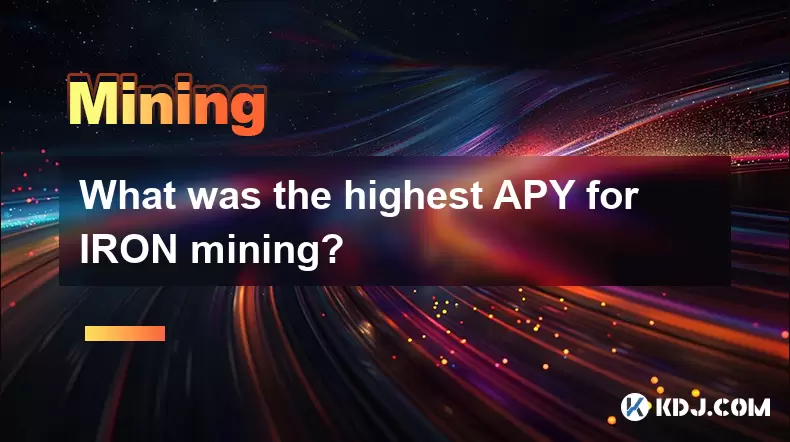
What was the highest APY for IRON mining?
Jul 23,2025 at 05:14am
Understanding IRON Token and Its Mining MechanismThe IRON token is a stablecoin that operates within the Iron Finance ecosystem, primarily on blockcha...

What is impermanent loss in IRON pools?
Jul 23,2025 at 09:00am
Understanding Impermanent Loss in the Context of IRON PoolsImpermanent loss is a phenomenon that affects liquidity providers in decentralized finance ...
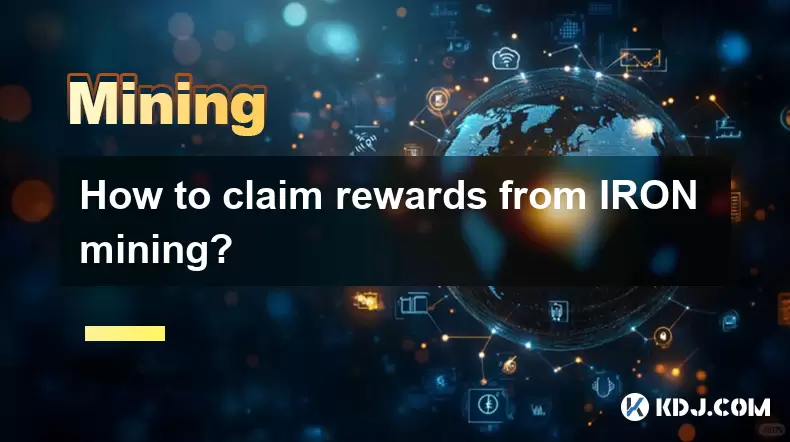
How to claim rewards from IRON mining?
Jul 23,2025 at 02:21pm
Understanding IRON Mining and Reward MechanismsIRON Finance operated as a decentralized finance (DeFi) protocol on the Polygon and Binance Smart Chain...
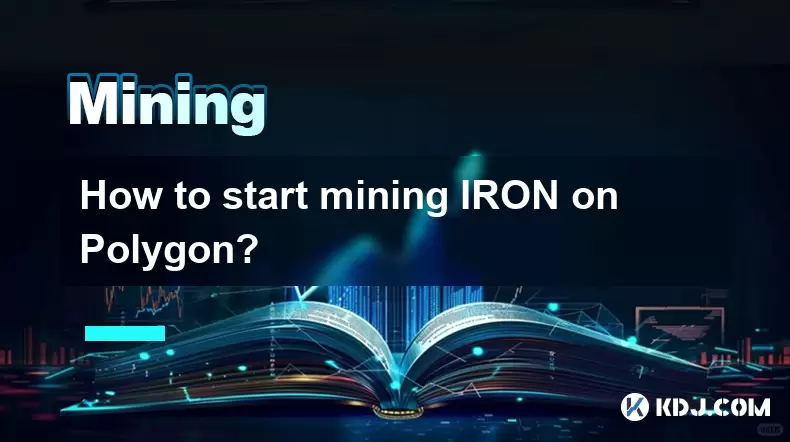
How to start mining IRON on Polygon?
Jul 23,2025 at 08:00pm
Understanding IRON and Its Role on PolygonIRON is a decentralized, algorithmic stablecoin designed to maintain a 1:1 peg with the US dollar. It operat...
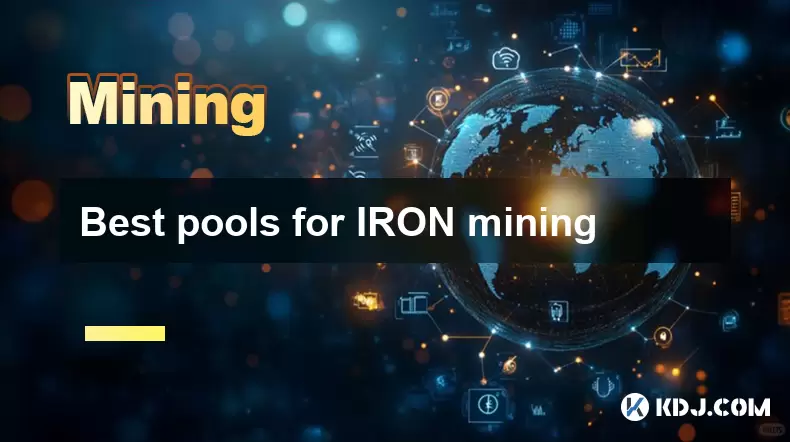
Best pools for IRON mining
Jul 26,2025 at 03:56am
Understanding IRON Mining and Its Unique MechanismIRON (Iron Finance) was a decentralized finance (DeFi) project that aimed to create a multi-chain al...
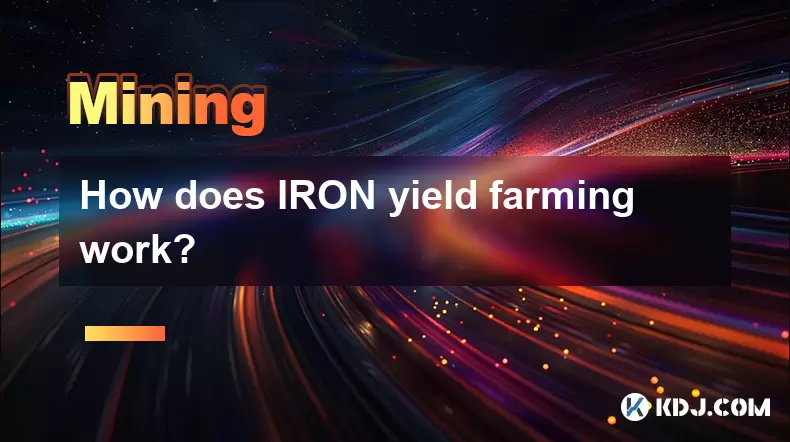
How does IRON yield farming work?
Jul 23,2025 at 10:14pm
Understanding IRON Yield Farming and Its Core MechanismIRON yield farming is a decentralized finance (DeFi) strategy that allows users to earn rewards...

What was the highest APY for IRON mining?
Jul 23,2025 at 05:14am
Understanding IRON Token and Its Mining MechanismThe IRON token is a stablecoin that operates within the Iron Finance ecosystem, primarily on blockcha...

What is impermanent loss in IRON pools?
Jul 23,2025 at 09:00am
Understanding Impermanent Loss in the Context of IRON PoolsImpermanent loss is a phenomenon that affects liquidity providers in decentralized finance ...

How to claim rewards from IRON mining?
Jul 23,2025 at 02:21pm
Understanding IRON Mining and Reward MechanismsIRON Finance operated as a decentralized finance (DeFi) protocol on the Polygon and Binance Smart Chain...

How to start mining IRON on Polygon?
Jul 23,2025 at 08:00pm
Understanding IRON and Its Role on PolygonIRON is a decentralized, algorithmic stablecoin designed to maintain a 1:1 peg with the US dollar. It operat...

Best pools for IRON mining
Jul 26,2025 at 03:56am
Understanding IRON Mining and Its Unique MechanismIRON (Iron Finance) was a decentralized finance (DeFi) project that aimed to create a multi-chain al...

How does IRON yield farming work?
Jul 23,2025 at 10:14pm
Understanding IRON Yield Farming and Its Core MechanismIRON yield farming is a decentralized finance (DeFi) strategy that allows users to earn rewards...
See all articles

























































































